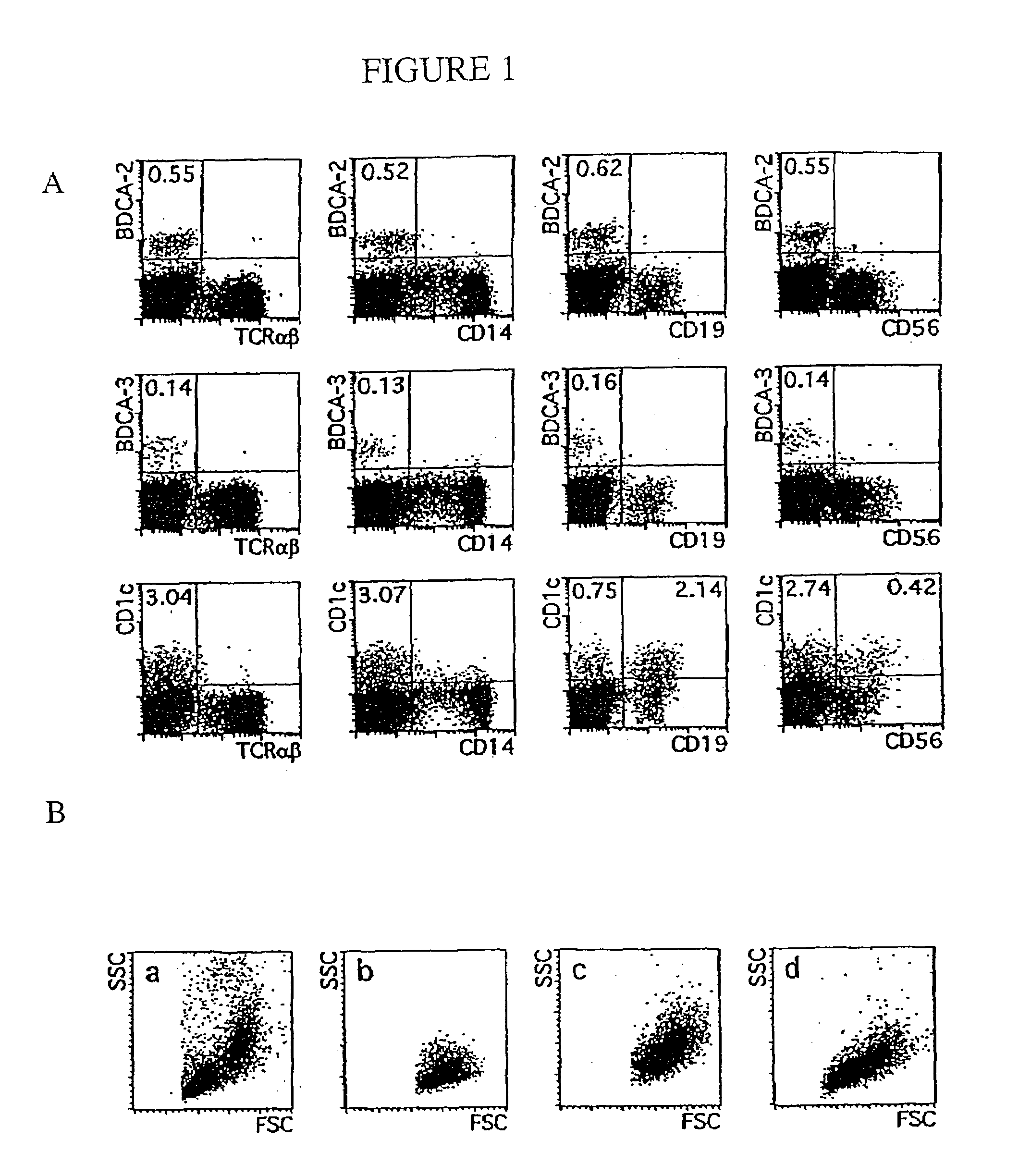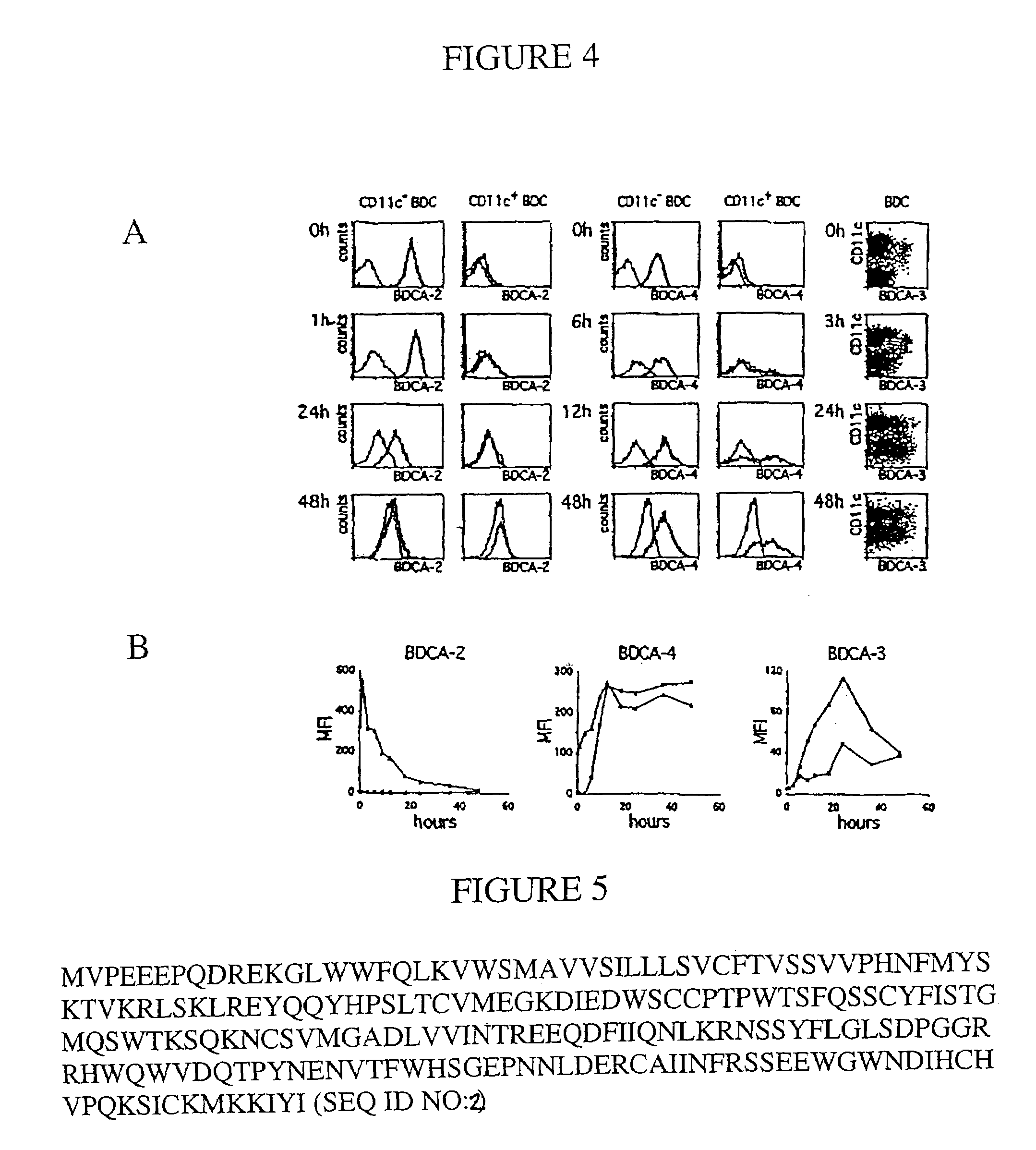Antigen-binding fragments specific for dendritic cells, compositions and methods of use thereof antigens recognized thereby and cells obtained thereby
- Summary
- Abstract
- Description
- Claims
- Application Information
AI Technical Summary
Benefits of technology
Problems solved by technology
Method used
Image
Examples
example 1
Generation of DC-Specific mAb
[0305]Five 6–8 week old female Balb / c mice (Simonsen Laboratories, Gilroy, Calif.) were inoculated with approximately 5×105 to 1×106 purified HLA-DR+lin−blood DC under anesthesia on d 0, 4, 7, 11, and 14 in the right hand footpad, and approximately 1×106 HLA-A2+ Bristol-8 B lymphoblastoma cells in the left hand footpad on d-3, 0, 4, 7, 11, and 14. Both cell types were incubated with 1:100 PHA (Gibco / BRL, Gaithersburg, Md.) for 10 min at room temperature and washed with PBS before injection. This treatment provides non-specific adjuvant effects and obviates the need for adjuvants such as Freund's adjuvant.
[0306]On d 15, one day after the fifth injection of HLA-DR+lin−DC, the mouse right hand popliteal lymph nodes were removed. A lymphocyte suspension was prepared and the cells were fused to SP2 / 0 Ag14 myeloma cells using a modification of the method described by Kohler and Milstein (1975) Nature 256:495. Fused cells were plated on 96-well plates in DMEM s...
example 2
Flow Cytometric Analysis of Blood DCs
[0317]A FACScalibur (BD Biosciences) was used for one-, two-, three- or four-color flow cytometry. Data of 5×103 to 2×105 cells per sample were acquired in list mode and analyzed using CellQuest software (BD Biosciences).
[0318]The following mAb (clone names) were used in this study for flow cytometry: CD1a (HI149), CD10 (H110a), CD11a (G43-25B), CD11c (B-ly6), CD25 (M-A261), CD27 (M-T271), CD32 (FL18.26), CD38 (HIT2), CD40 (5C3), CD43 (IG10), CD54 (HA58), CD62L (Dreg 56), CD64 (10.1), CD69 (FN50), CD98 (UM7F8), anti-HLA-DQ (TU169), and anti-TCRαβ T10B9.1A-31 from Pharmingen, San Diego, Calif.; CD2 (S5.2), CD8 (SK1), CD13 (L138), CD14 (MFP9), CD19 (SJ25-C1), CD33 (P67.6), CD34 (8G12), CD45RO (UCHL-1), CD56 (NCAM16.2), CD71 (LO1.1), CD123 (9F5), ariti-IgD (TA4.1), anti-mouse IgG1 (X56), anti-mouse IgG2 (X57), and anti-mouse IgM (X54) from BD Biosciences; CD5 (CLB-T11 / 11, 6G4), CD7 (CLB-T-3A1 / 1, 7F3), CD16 (CLB-FcR gran / 1, 5D2), CD45RA (F8-11-13), C...
example 3
Cross-Inhibition, Co-Capping and Co-Internalization Analysis
[0322]To analyze whether two different mAb clones recognize the same (or a closely related) antigen epitope, cross-inhibition binding assays were performed. Between 1×106 and 2×106 cells were pre-incubated with one of the two mAb clones at a concentration of about 100 μg / ml for 10 min at 4° C., and then stained with a PE-conjugate of the other mAb clone at its optimal titer for another 5 min at 4° C. PBMC were used to analyze cross-inhibition of BDCA-2-, BDCA-3-, and BDCA-4-specific mAb clones and MOLT-4 cells were used to analyze cross-inhibition of CD1c-specific mAb clones. Cell staining was analyzed by flow cytometry.
[0323]To ascertain whether AD5-5E8 and AD5-14H12 recognize the same antigen (or the same antigen-complex) a co-capping assay was performed. Briefly, BDCA-3-expressing cells were isolated from PBMC by indirect magnetic labeling with PE-conjugated AD5-14HI2 mAb and anti-PE mAb-conjugated microbeads, and isolat...
PUM
| Property | Measurement | Unit |
|---|---|---|
| Fraction | aaaaa | aaaaa |
| Fluorescence | aaaaa | aaaaa |
| Chemiluminescence | aaaaa | aaaaa |
Abstract
Description
Claims
Application Information
 Login to View More
Login to View More - R&D
- Intellectual Property
- Life Sciences
- Materials
- Tech Scout
- Unparalleled Data Quality
- Higher Quality Content
- 60% Fewer Hallucinations
Browse by: Latest US Patents, China's latest patents, Technical Efficacy Thesaurus, Application Domain, Technology Topic, Popular Technical Reports.
© 2025 PatSnap. All rights reserved.Legal|Privacy policy|Modern Slavery Act Transparency Statement|Sitemap|About US| Contact US: help@patsnap.com



